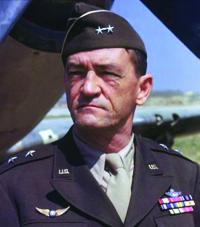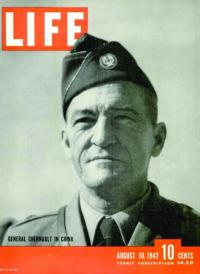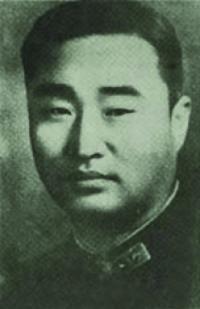
American Gen. Claire Lee Chennault

Aug., 1942 Life Magazine cover of Flying Tigers’ cmdr., American Gen. Clair Chennault.

Chinese Gen. Fang Zianjue, cmdr. 10th Army.

Gen. Shunroku Hata, Imperial japanese Army, China Expeditionary Army cmdr.

Pres. Franklin D. Roosevelt & Prime Minister Winston S. Churchill at the First Cairo Conference, Nov., 1943.
THIS WEEK, 70 years ago, the Imperial Japanese Army, having failed three prior times, launched a fourth assault on the 2,000 year old Chinese City of Changsha, which is the Capital of Hunan Province. It is located on the Hsiang River and was an important railroad junction, linking the city to Canton, Wuhan and Guangxi. Today, Changsha is home to more than 7,000,000 Chinese. Former Chairman, Mao Zedong, began his political career there, first as a student at Hunan No. 1 Teacher’s Training School, and later as teacher and principal at the same school. It is the birthplace of the Chairman’s second wife - Yang Kaihui, who was executed by his Chinese enemies in 1930.
The Imperial Japanese Army’s China Expeditionary Army commander, General Shunroku Hata, ordered the 11th Army, under the command of Isamu Yokoyama, to capture Changsha as the second part of Operation Ichi-Go. For the coming battle, General Yokoyama’s 11th Army had been reinforced from its basic five divisions, by adding four more, with three independent brigades. General Yokoyama launched his offensive on May 27, 1944. On June 2, General Hata was promoted to Field Marshal.
Changsha was in the 9th Military Front, which was commanded by Xue Yue. The Chinese Army’s 4th Corps, under the command of Zhang De-neng was responsible for the defense of Changsha. That proved to be the difference in the result of the Fourth Battle and the first three. General Yue did not, personally, command the city’s defenses, as he had in the previous battles.
General De-neng disobeyed a direct order from General Yue and ordered a general retreat. Worse, while his soldiers were retreating, he ran. The city fell on June 19. General De-neng was arrested on the orders of General Yue, court martialed and sentenced to five years in prison. This sentence was later overruled by Generalissimo Chiang Kai-shek, who ordered him executed.
However, this was not the end of Operation Ichi-Go. The next target was the city of Heng Yang, which is the second largest city in Hunan Province. In English, it is known as Heng Chow. With over 100,000 men, General Yokoyama’s 11th Army began assaulting Heng Yang. It was very important for the Japanese to capture Heng Yang, because the airport was used by American General Clarie Lee Chennault’s Flying Tigers. On June 2nd the Generalissimo ordered the 10th Army, under the command of General Fang Xianjue to proceed to Heng Yang.
The total number of Chinese soldiers assigned to defend the city was 17,000. For the next month they worked feverishly constructing defenses. At 8:00 p.m. on June 22, 1944, General Yokoyama sent two of 11th Army’s divisions, 68th and 116th, against the city. General Yokoyama anticipated the city would fall within two days. Making no progress, General Yokoyama halted the offensive on July 2. He resumed the offensive on July 11. On July 18 he threw in three more divisions - the 40th, 58th and the 13th. Finally, on August 8, 1944, what was left of the Chinese force surrendered after General Xianjue extracted a promise from the Japanese not to harm the civilian population and to treat the wounded humanely.
The Siege of Heng Yang had cost the Japanese 30,000 casualties and had lasted 47 days. It was the longest siege of the war.
General Fang and his officers were liberated in December 1944 by a daring rescue mission commanded by General Dai Li. Upon his arrival in the Chinese capital of Chongging, General Fang was feted as a hero and decorated with the highest honor for a Chinese commander. Although Operation Ichi-Go had forced the United States Army Air Force to relocate, this had very little effect on the American bombing campaign of the Japanese Home Islands, since now the USAAF had the use of bases on Saipan. The prolonged defense of Heng Yang and the capture of Saipan resulted in the fall of the government of General Hideki Tojo.
Operation Ichi-Go involved the largest number of Japanese soldiers - 400,000 - in the war. Also involved were 70,000 horses, 12,000 vehicles, 1500 artillery pieces and 800 tanks. Although the Operation allowed the Japanese to link the territories under their control, it also required them to defend more, thereby stretching their resources and making their forces more vulnerable to guerilla activity.
Upon General Fang’s death, in 1983, surviving veterans of the Japanese 11th Army traveled, as a group, to Taipei to pay their respects.
NEXT: LIBERATION OF ROME
Mr. Wimbrow writes from Ocean City, Maryland, where he practices law representing those persons accused of criminal and traffic offenses, and those persons who have suffered a personal injury through no fault of their own. Mr. Wimbrow can be contacted at
wimbrowlaw@gmail.com



